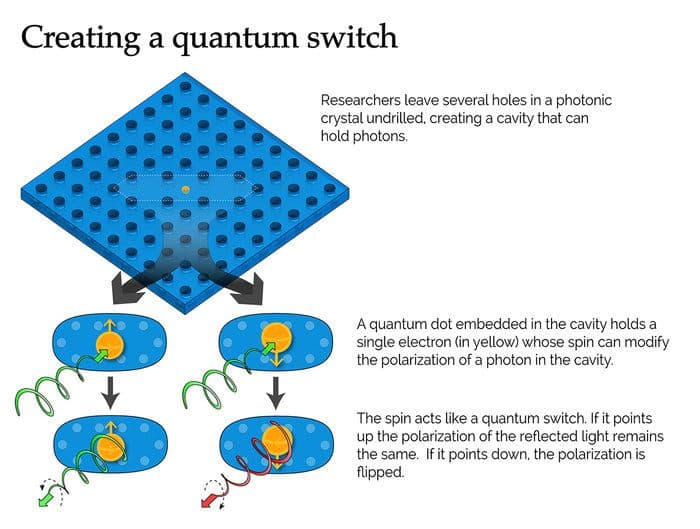Incorporating Qubits In Solid State Devices Might Enhance Quantum Networks
A research team from the Joint Quantum Institute have developed a way for qubits to interact with photons, which could ultimately lead to futuristic quantum networks. Theorists explained that such a solid state device could give birth to compact chip-integrated quantum circuits enabling gigahertz range bandwidths.
Qubits or quantum bits which are the quantum analogue of the classical bit allows superposition of states in between horizontally polarized and vertically polarized states. Contemporary optical networks use electronic circuits to store information and an optical fibre to carry it. However, scientists sketched a quantum network system in which highly secured qubits will be transmitted using an optical fibre. However, in order to realise this in practice will require a feasible interaction between an electron and a photon.

photon-spin interactions in a quantum dot
Recently, researchers belonging to the group of Edo Waks, a research fellow at JQI and an Associate Professor in the Department of Electrical and Computer Engineering at the University of Maryland encountered an electron-photon interface that leads to the formation of the aforementioned system. The team did this by trapping a photon and an electron together in a narrow space, thereby agitating the electron to change the quantum state of the photon and vice versa.
The scientists first trapped light in an extremely small volume inside a photonic crystal where they used Nano-crystals called quantum dots having an electron trapping property. The group used a photonic crystal having 72 nanometre wide space and left 3 holes undrilled. This particular structure worked as a filter which supports only certain photons having precise values of energy.

Inside this cavity, a quantum dot with an electron is embedded. The spin of that electron was in charge of controlling a surge of photons from a Laser inside the cavity. If the spin pointed up, a photon entered the cavity and did not disturb its own polarization but when the spin pointed down, any photon that entered the cavity got its polarization reversed and vice versa.
Using this process, electrons could be used to accumulate quantum information whereas photons would be responsible for shuffling the information in a wide networking system. The research was supported by the University of Maryland (UMD), the National Institute of Standards and Technology and the Laboratory for Physical Sciences. The whole report was published in the “Nature Nanotechnology†journal.
Source:Nanoscale cavity strongly links quantum particles | UMD Joint Quantum Institute | #-Link-Snipped-#
Qubits or quantum bits which are the quantum analogue of the classical bit allows superposition of states in between horizontally polarized and vertically polarized states. Contemporary optical networks use electronic circuits to store information and an optical fibre to carry it. However, scientists sketched a quantum network system in which highly secured qubits will be transmitted using an optical fibre. However, in order to realise this in practice will require a feasible interaction between an electron and a photon.

photon-spin interactions in a quantum dot
The scientists first trapped light in an extremely small volume inside a photonic crystal where they used Nano-crystals called quantum dots having an electron trapping property. The group used a photonic crystal having 72 nanometre wide space and left 3 holes undrilled. This particular structure worked as a filter which supports only certain photons having precise values of energy.

Inside this cavity, a quantum dot with an electron is embedded. The spin of that electron was in charge of controlling a surge of photons from a Laser inside the cavity. If the spin pointed up, a photon entered the cavity and did not disturb its own polarization but when the spin pointed down, any photon that entered the cavity got its polarization reversed and vice versa.
Using this process, electrons could be used to accumulate quantum information whereas photons would be responsible for shuffling the information in a wide networking system. The research was supported by the University of Maryland (UMD), the National Institute of Standards and Technology and the Laboratory for Physical Sciences. The whole report was published in the “Nature Nanotechnology†journal.
Source:Nanoscale cavity strongly links quantum particles | UMD Joint Quantum Institute | #-Link-Snipped-#
Replies
You are reading an archived discussion.
Related Posts
National Programme on Technology Enhanced Learning .It is a project founded by ministery of human resource development provides e-learning on various courses such as engineering ,science etc .It is a...
Lenovo is all set to launch the global variant of its locally successful handset, the Lenovo Lemon 3 at the upcoming Mobile World Congress that is scheduled to be held...
While other smartphone manufacturers wait until the Mobile World Congress to launch their new devices, Microsoft has jumped the gun and unveiled its first mid-range Windows 10 Mobile offering, the...
A group of researchers from the Wake Forest Baptist Medical Center has invented an economical and non-invasive technology to detect the presence of Cancerous cells as well as other life...
I had been a dont net developer for 5 years then there is a bad turn in my life and i had to discontinue with my Programming field. No its...
